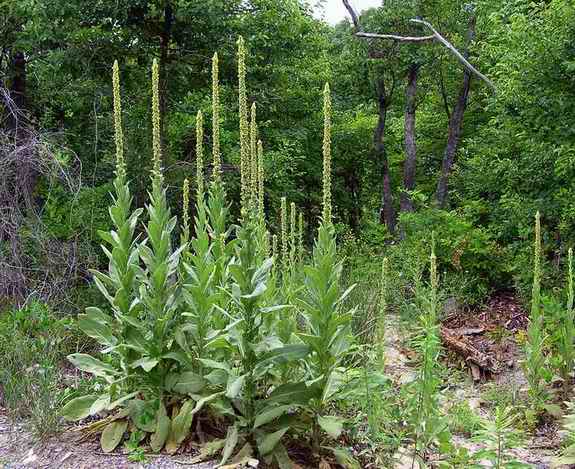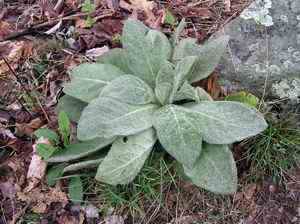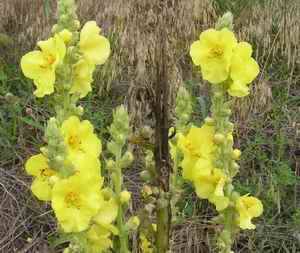|
Return to Hiker's Notebook Website
Common Name: Common Mullein, Great mullein, Torches, Candlewick plant, Hag's taper, Aaron's rod, Jacob's staff , Our lady's flannel, Beggar's blanket, Hare's beard, Velvet dock, Rag paper, Wild ice leaf, Bullock' lungwort, Clown's lungwort, Blanket herb, Feltwort, Quaker rouge - Mullein is from the Latin word "mollis" which means soft; reference to the soft, velvety leaves of the plant.
Scientific Name: Verbascum thapsus - The generic name is the Latin name for mullein, as the plant originates and is very common in Europe. Verbascum is a corruption of barbascum, Latin for "with beard" in reference to the small hairs on the leaves of the plant. Thapsus is the name of an ancient town in North Africa near Carthage where the forces of Julius Caesar defeated those of Scipio in 46 BCE to end the efforts of the statesman Cato to create a republican form of government in Rome; it is presumably where mullein was first characterized as a species.
Common Mullein was first introduced to North America in the 18th Century, where it was used as a fish poison in Virginia. By 1876, it had reached California. It is native to Europe and the temperate regions of Asia and North Africa; its myriad names attest to a wide-ranging cultural etiology. The fine hairs on the leaves and stem afford the plant an exceptional flammability that has been historically used for sustained combustion. Before the discovery and cultivation of cotton, mullein was used for lamp wicks; the name "Candlewick Plant" was thus engendered. Although possibly apocryphal, Roman soldiers dipped mullein racemes (the central vertical stem to which the flowers are attached) in tallow and used them as lighted beacons; the common name "Torches" would support this assertion. "Hag's taper" refers to the superstition that the mullein torch was used by witches and other devil worshipers as a source of light for their incantations and rites. In both Europe and Asia, mullein was thought to be a sort of botanical amulet, capable of driving off evil spirits. For example, in Greek mythology, Odysseus was able to ward off the magic potions of the enchantress Circe by consuming an herb named "moly" that was provided by Hermes. With its magical powers, he was able to restore his men to human form from the spell that Circe had invoked to transform them to swine. It is hypothesized that "moly" was a shortened form for mullein. Mullein has several evolutionary adaptations that are well suited to its survival. It is a biennial, establishing a root structure during the first year to support the tall flowering spike (the names Jacob's staff and Aaron's rod refer) of the second year. The leaves are covered with small hairs that give them a velvety texture (the names Our lady's flannel, Beggar's blanket and Hare's beard refer). The hairs serve to reduce the amount of moisture lost to evaporation to promote growth in dry areas. The hairs are also mildly toxic, providing a defense against insects and grazing animals; the toxin irritating the mucous membranes of the mouth.
The leaves of the second year plant are alternate with smaller leaves at the
top and larger leaves at the bottom, decurrent so that water is directed
toward the roots, another adaptation for dry conditions. The large flowers
that extend up the stalk attract a wide range of pollinators due to the
readily accessible supply of nectar. The stamens are covered with tiny hairs
that are filled with sap that may also contribute to the attraction of
insects. External pollinators contribute to diversity in taking the pollen
from one
Mullein has been used in a variety of medicinal applications for centuries. William Cole was one of the principal British proponents of the doctrine of signatures doctrine of signatures; he noted in his herbal book Adam in Eden (1657) that "Husbandmen of Kent do give it (mullein) their cattle against cough of the lungs, and I, therefore, mention it because cattle are also in some sort to be provided for in their diseases." The name Bullock's lungwort refers to this application, Clown's lungwort for the similar use of mullein as folk medicine for the treatment of human pulmonary problems. A tea was made from the leaves and flowers of mullein as a demulcent for the treatment of colds, coughs, and other respiratory ailments such as tuberculosis. Caution was prescribed in the brewing process since the hairs of the leaves had to be totally removed from the liquid with a fine muslin sieve; their ingestion leading to severe itching in the mucous membranes of the mouth. Dried leaves were smoked in a tobacco pipe as a means of alleviating the debilitating cough of consumption.
Mullein was listed in the 4th edition of the United States National Formulary but was subsequently removed due to a lack of independent test validation. It is approved for use in Germany, however, and is listed in the German Drug Index for use as an expectorant to alleviate irritation and to treat catarrhs (inflamed mucous membranes) of the respiratory tract. Some limited testing has been conducted that indicates that verbascoside (from the genus name) is an effective antiseptic and antiviral agent, specifically in the treatment of herpes simplex type I and some influenza strains.
Due to its efficacy in the treatment of lung disorders, mullein was thought to provide some amelioration to the symptoms of many other conditions. Its astringent properties were thought to alleviate diarrhea and hemorrhoids. Oil extracted from the flowers was used to treat ear infections and earaches. A recent double blind test of 250 children with earaches compared the effectiveness of a mullein extract with that of standard anesthetics. Though pain was reduced for both treatments to an equivalent extent, a placebo effect was suspected. The analgesic properties of mullein are extolled in its promotion as a treatment for toothache, migraine headaches, cramps, and applied externally as a poultice for sunburn, chilblains and chapped lips.
Mullein has a number of other properties in addition to those of medicinal application that have engendered some interesting cultural applications. The seeds a compound, probably rotenone, which is toxic to fish; the etiological rationale for its importation to North America was to kill fish. A methanol extract from the leaves has been employed in the eradication of mosquito larvae. The soft, wooly leaves of the first year rosette were once placed inside of shoes to afford some comfort and warmth. An infusion of the flowers was used by the women of Ancient Rome to dye their hair a golden color. Due to the proscriptions against cosmetics in the Quaker religion, Quaker women used the mullein to apply color to their cheeks; the plant thus earned yet one more common name, Quaker rouge. |


 plant
and using it to fertilize another, creating a possible hybrid that would then
be selected according to any advantage that may have been afforded toward a
fitness for survival. The mullein goes one step further in that it is also
capable of self pollination, the species being perpetuated even in the absence
of active external agents. Because of the size of the stalk and the number of
flowers with their concomitant seed capsules, mullein is profligate. It is
estimated that a single mullein plant can produce more than 150,000 seeds that
can remain viable for more than 100 years because they are pitted and rough
with deep and hardened grooves.
plant
and using it to fertilize another, creating a possible hybrid that would then
be selected according to any advantage that may have been afforded toward a
fitness for survival. The mullein goes one step further in that it is also
capable of self pollination, the species being perpetuated even in the absence
of active external agents. Because of the size of the stalk and the number of
flowers with their concomitant seed capsules, mullein is profligate. It is
estimated that a single mullein plant can produce more than 150,000 seeds that
can remain viable for more than 100 years because they are pitted and rough
with deep and hardened grooves.